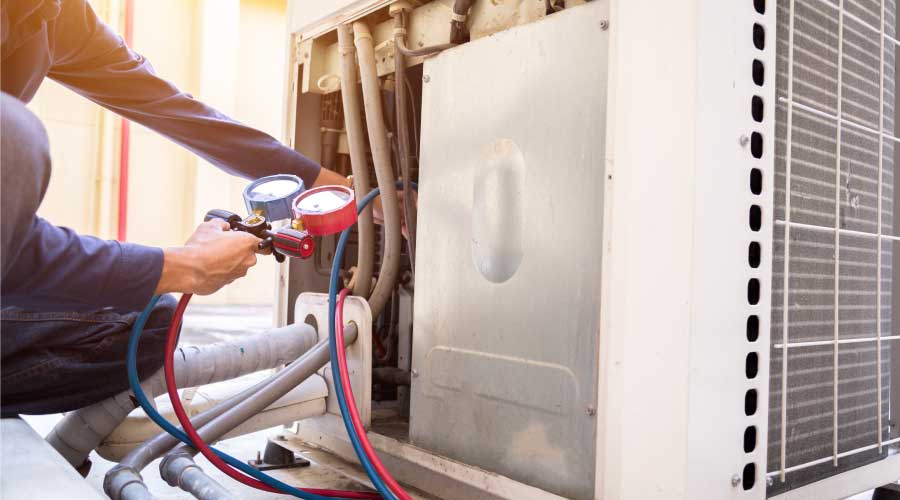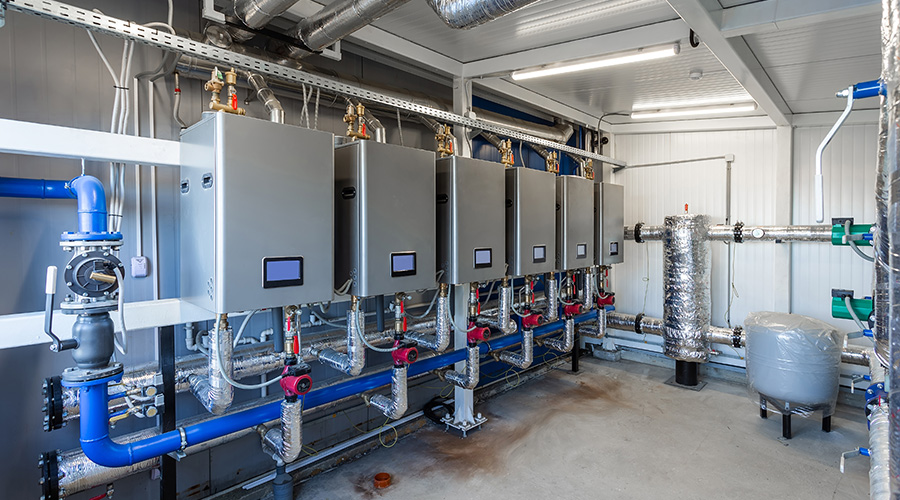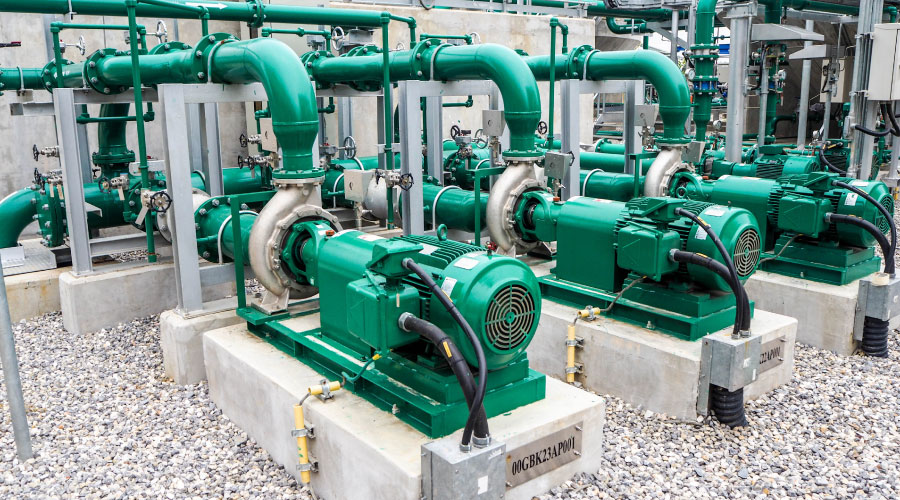Pumps: Maintaining Building’s 'Hearts'
Providing maintenance that maximizes pump performance requires that managers understand issues such as monitoring and lubrication
Like human hearts, pumps fall into that category of equipment that is out of sight and, too often, out of mind. For that reason, many organizations fail to understand the central role that pumps play in the smooth operation of facility systems and operations.
Ensuring that pumps perform efficiently and reliably — in short, ensuring pump’s health — requires a coordinated effort by maintenance and engineering departments. A well-planned predictive and preventive maintenance (PPM) program is vital to keep pumps running efficiently over an extended period of time.
Technicians must regularly monitor four characteristics as part of a good PPM program: pump vibration, pump performance, bearing condition and lubrication quality.
Good and Bad Vibrations
Pumps become dynamically imbalanced for a number of reasons, including improper baseplate installation, coupling imbalance, bearing failure, clogged impeller and operating too close to its natural frequency. All pumps exhibit some vibration. The trick is to determine when the amplitude of the vibration has reached the point indicating pump distress. If technicians detect a vibration irregularity, prompt diagnosis and corrective action is called for to avoid major problems.
Technicians should take pump vibration readings in the vertical and horizontal directions on the inboard and outboard side of both the pump and the motor, as well as axially on the pump itself. During these readings, it is very important to record two measurements: the pump operating point and how far this figure is from the pump’s best efficiency point (BEP). The BEP is the flow through the pump that produces the least amount of vibration. Operation at flows other than the BEP can produce higher levels of vibration.
The frequency of a suspect vibration is related directly to the underlying problem, whereas the amplitude of the vibration can indicate its severity. In any case, prompt detection, analysis and intervention are essential for avoiding failures.
Monitoring Performance
Another important checkup for pump health is performance. This includes checks on the total head, flow and pump speed, as mentioned above. Running a pump at flow that is too low can cause overheating, whereas a flow that is too high might produce unacceptable internal hydraulic forces. Exactly where a pump will operate on its curve depends on the characteristics of the system to which it is connected. The operating point changes as system characteristics change due to modulating valves and increasing demand.
The presence of air in a pump can affect its flow performance, as well as cause major damage to internal parts. Air can enter a pump by several means, including deteriorated gaskets, improperly adjusted stuffing boxes, vortexes in supply tanks, and cavitation.
Technicians can detect cavitation by listening for what sounds like gravel being churned in the pump. This sound results from bubbles formed when the vapor pressure of the pumped material exceeds the pressure in the pump and collapse as pressures increase.
Pumping liquids near their vapor points is especially risky. Reports of major damage to impellers due to this phenomenon are not unusual. Corrective measures to address cavitation include regularly cleaning strainers, filters and screens on the suction piping and avoiding obstructions, such as partially closed valves on suction piping.
Technicians can determine pump total head by comparing readings on suction and discharge gauges. But they should remember that velocity head must be added to these residual readings and gauge readings corrected to the centerline of the pump.
Technicians can determine pump flow by using instruments such as flow meters, pitot tubes and Doppler devices. It is important that they check these instruments periodically for accuracy and re-calibrate as required.
Pumps usually are rated using pure water at a particular temperature, typically 60 degrees, where viscosity is 1.12 centistokes and specific gravity is 1.0. Pumping water at other temperatures or pumping other liquids, such as glycol solutions, will alter the pump curve. So technicians must take pumpage chemistry and temperature readings during flow tests. Then, they can adjust results to compensate for any deviations for comparison with previous tests.
Of course, testing also must include motor performance. Higher-than-normal amp draw might indicate problems with the pump, including stuffing packing too tight, obstructions in the pump, or facility voltage or power factor problems.
Bearing Considerations
Bearings serve as the interface between a pump’s moving and non-moving parts. If bearings are not in essentially perfect condition, damage will occur to the pump shaft, raceways and other bearings.
Increasing noise and vibration are the most noticeable signs of bearing problems. Temperatures also will increase due to increased friction. Low flows can cause evaporation of the lubricant between bearings, whereas high flows can damage bearings due to unacceptably high axial forces.
Flow meters with transducers or motor-load monitors can help technicians ensure that unacceptable flow conditions trigger an alert and shut down the pump to protect the bearings.
Magnetic drive pumps typically use plain bearings made of silicon carbide, which have excellent chemical resistance, dimensional stability and low wear. These bearings, however, exhibit very high frictional losses when not adequately lubricated or cooled.
Some manufactures now offer silicon carbide bearings with special coatings that allow the bearings to run dry for up to five minutes without substantial damage. Using such bearings is recommended where material being pumped is near its boiling point or where it contains high solids content.
The frequency of bearing monitoring depends on the duty of the pump. Some pumps might need only semi-annual or quarterly checkups, but others operating under harsher conditions might require monthly or even daily monitoring. Manufacturer recommendations paired with maintenance experience will usually establish the best routine.
The sophistication of acoustic monitoring technology for bearings varies from simple stethoscopes to high-tech electronic equipment, including sonic and ultrasonic listening devices. Higher-end equipment might produce graphs that technicians can analyze to determine bearing condition to a great degree of precision.
Technicians should immediately replace any bearings that have pits, nicks or flat spots. Spending a few dollars for new bearings is nothing compared to the cost of a catastrophic pump failure.
Looking at Lubricants
No discussion of bearing health is complete without talking about lubrication. Tech- nicians can control bearing friction and degradation by using specially formulated greases and oils.
Maintaining lubricants at proper levels and temperatures, as well as their quality, can greatly extend bearing life. Bearings are given what manufacturers refer to as an L10 life. This number refers to the revolutions that 90 percent of the bearings can be expected to provide under normal use and operating with proper lubrication. Improp-er lubrication, however, can greatly reduce the actual life of a bearing.
The greatest danger to bearings is the presence of debris and water in the lubricant. When technicians inspect or replace bearings, it is critical that they maintain a clean environment. Debris from technicians’ hands or surfaces on which bearings are placed are typically the cause of problems.
To prevent such problems, technicians must keep hands clean and place bearings on clean cloths. Also, they should cover shafts and housings with clean cloths.
Water or moisture in lubricants not only can reduce bearing life; it also can damage the lubricant itself. Depending how saturated the lubricant is, water can exist in three states: free, emulsified and dissolved.
Free and emulsified water levels must not exceed 100-300 parts per million, depending on the oil used and the operating temperature. Technicians can use several on-site methods to check the amount of water, including the crackle test, certain reagents such as calcium hydride, and relative humidity monitors.
Finally, technicians should not overlubricate greased bearings because it can lead to overheating. When this occurs, grease can leak into the cavity, reducing its effectiveness. Using ultrasonic listening devices can reveal when a bearing needs grease, as well as when it has the proper amount.
Pump Pre-installation Issues
Before installing pumps, maintenance and engineering managers must give proper attention to the pump’s location. This consideration can ensure that technicians will be able to perform maintenance in a safe and efficient manner. It is too easy for technicians to ignore pumps that are difficult to access.
In the construction phase, contractors and vendors must ensure that pumps are installed properly, with special attention to proper coupling alignment, pump mounting, motor-rotational direction and, the installation of specified thermocouples, pressure gauges, flexible connections, etc. Technicians must accurately follow installation and startup instructions.
Once pumps are in place and operational, it is critical that technicians create a baseline performance record. This record should include readings on suction and discharge pressures, flow, current draw, pump speed, bearing temperatures, vibration readings, and characteristics of fluids being pumped, including temperature, specific gravity and viscosity. They can compare the data to subsequent test readings to determine if any changes have occurred that might indicate possible problems.
|
Edward E. Hale, BSME, CPD, is a senior plumbing and fire protection designer for Smith Seckman Reid Inc. an engineering design and facility consulting firm.
Related Topics:











